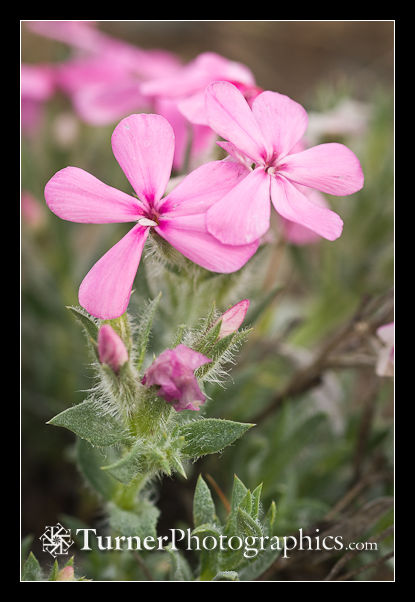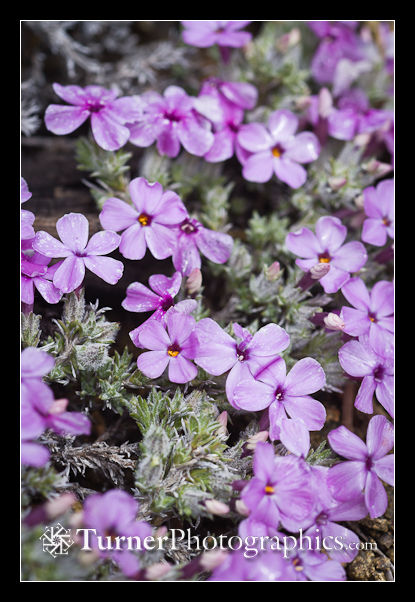Phlox on the Rocks
 The latest Rock Garden Quarterly arrived in my postal mailbox today with a bunch of my photos from Deception Pass State Park to help promote the upcoming Western Winter Study Weekend. There’s a link to this blog, so I figured I’d better get busy and write something new for the hoards of visitors coming my way.
The latest Rock Garden Quarterly arrived in my postal mailbox today with a bunch of my photos from Deception Pass State Park to help promote the upcoming Western Winter Study Weekend. There’s a link to this blog, so I figured I’d better get busy and write something new for the hoards of visitors coming my way.
I’m working on selecting photos for the new Trees and Shrubs of the Northwest book due out in 2013. Today was Polemoneaceae day, or in plain English, a day of selecting pictures of Phlox.
The beauty at right is Yreka Phlox, Phlox hirsuta. It’s a certified rare plant that only grows in a few locations on the outskirts of Yreka, California. I photographed it back in the spring of 2004 when I was working on the wildflowers book with Phyllis Gustafson. It’s one of the plants that ended up on the proverbial cutting room floor and got left out of the first book. Ellen and I plan to include it in the trees & shrubs book.
 Yreka Phlox is a diminutive little thing, growing only a few inches tall and forming small buns on serpentine. The Latin species name, hirsuta, refers to the very hairy foliage and stems. It’s a strict serpentine endemic, which means that you’ll only find it on serpentine. Even if it weren’t on the rare plant list you’d be hard-pressed to get it to grow in your garden. Don’t even think of trying it.
Yreka Phlox is a diminutive little thing, growing only a few inches tall and forming small buns on serpentine. The Latin species name, hirsuta, refers to the very hairy foliage and stems. It’s a strict serpentine endemic, which means that you’ll only find it on serpentine. Even if it weren’t on the rare plant list you’d be hard-pressed to get it to grow in your garden. Don’t even think of trying it.
This is one of the rarest members of the Phlox family. According to the California Native Plant Society Inventory of Rare and Endangered Plants it’s known from only four locations near Yreka. The hillside where I photographed it is under development pressure as houses creep upward from the valley floor.
The US Fish & Wildlife Service 2006 Recovery Plan states, “Although the biology and ecology of Phlox hirsuta are poorly understood, field observations suggest that its populations may be stable, individual plants may be long-lived, and seedling establishment is infrequent.” The linked document gives a tremendous amount of detail about this very interesting rare plant. If you’re visiting the Yreka area between late February and June it’s worth seeking out one of the locations where it grows. I’ll leave it to you to figure out where those are from the official literature.
 Considerably more common is Clustered Phlox, Phlox caespitosa. It’s found at higher elevations in many California, Oregon, and Washington Counties.
Considerably more common is Clustered Phlox, Phlox caespitosa. It’s found at higher elevations in many California, Oregon, and Washington Counties.
This specimen was photographed along the roadside on California Rt. 3 between Callahan and Scott Mountain. I’ve also found it near Bickleton in central Washington. This is another plant that got left out of Wildflowers of the Pacific Northwest when we had too many plants and not enough pages.
 I can’t remember now what I was looking for when I spied this bright red-purple bun along the highway, but the phlox definitely caught my eye and made my stop to check it out. It’s a plant that favors dry, rocky habitats but isn’t too particular about the elevation or soil, except that it usually isn’t found on serpentine.
I can’t remember now what I was looking for when I spied this bright red-purple bun along the highway, but the phlox definitely caught my eye and made my stop to check it out. It’s a plant that favors dry, rocky habitats but isn’t too particular about the elevation or soil, except that it usually isn’t found on serpentine.
Yreka phlox and clustered phlox are superficially similar. They’re both low-growing plants found on rocky sites. They have a woody base. Both have somewhat hairy foliage. But Yreka phlox is always found on serpentine and clustered phlox is almost never found on serpentine. Yreka phlox is almost always pink, as shown in the photos above. Clustered phlox is variable, but more likely to be purplish or white than pink.
Neither plant appears to be available in the nursery trade.
You can find more photos of both of these species of phlox on my Pacific Northwest Wildflowers website. Here’s the Yreka Phlox page, and this is the one for Clustered Phlox.
Shameless plug for the book: Wildflowers of the Pacific Northwest, which includes neither of these species of phlox, but does have 1220 other cool plants, is available autographed from the buy the book link on my wildflowers website or if you’re a cheapskate it’s on Amazon as Wildflowers of the Pacific Northwest. Disclosure: if you buy it from Amazon with this link I get a few cents.
I write monthly (1st of the month) about native plants on the group blog, Native Plants and Wildlife Gardening. Check it out. Also you can get some free promo codes and neimanmarcus coupons by visiting the site below!

